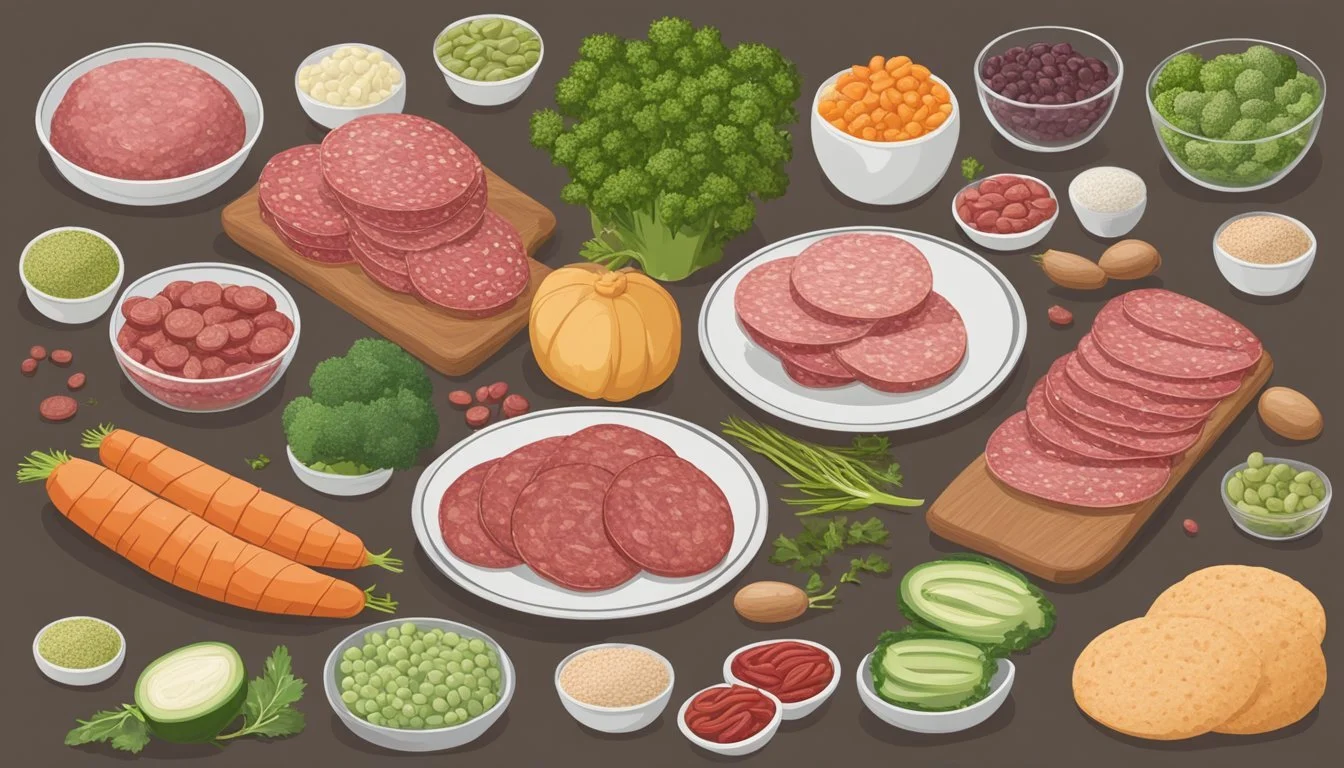Salami Substitutes
Tasty Alternatives for Every Diet
For those who savor the rich taste of salami but seek alternatives for dietary, health, or ethical reasons, it's comforting to know there are plenty of delicious substitutes available. Seitan, a versatile vegan protein derived from wheat gluten, makes for an excellent replacement with its hearty texture and ability to absorb flavors. It's perfect for sandwiches and charcuterie boards alike.
Another popular choice is vegan salami, typically crafted from soy, seitan, and an array of spices. This plant-based option can mimic the taste and function of traditional salami in various dishes, including sandwiches and platters. For those craving a different twist, pepperoni, turkey, or chicken breast sliced thinly can provide that familiar cured meat experience without pork.
These alternatives not only cater to different dietary needs but also bring an exciting variety to your culinary repertoire. Dive into these options and discover how they can elevate your meals while aligning with your lifestyle.
Understanding Salami
Salami is a type of cured sausage that originates from Italy. It is traditionally made from pork, although beef variations also exist.
Salami is typically fermented and dry-cured, which helps in its preservation and gives it its distinctive flavor.
Ingredients commonly used in salami include:
Pork or Beef: The primary meat used.
Spices: Black pepper, fennel seed, and garlic are common.
Salt and Sugar: Essential for the fermentation process.
Fermentation is a key step that involves beneficial bacteria converting sugars into acids, contributing to the salami’s unique taste and texture.
After fermentation, the salami is dry-cured. This involves hanging the sausage in a controlled environment to lose moisture while developing its flavors.
Types of Salami:
Genoa Salami: Made with pork, black pepper, and garlic.
Italian Sausage: Contains fennel seeds and various spices.
Salami is often enjoyed in slices, making it a popular choice for charcuterie boards, sandwiches, and pizzas.
The use of black pepper and fennel seeds adds a spiced flavor, while garlic contributes a robust taste.
Salami can also be compared to other Italian cured meats like dry-cured ham, which shares similar preservation methods.
By understanding the ingredients, process of fermentation, and the curing techniques, one can appreciate the complexity and craftsmanship involved in making salami.
Health and Environmental Considerations
Meat substitutes like salami alternatives are increasingly popular due to their potential health and environmental benefits. They often contain lower levels of saturated fat and cholesterol compared to traditional processed meats.
Nutritional Content:
Rich in fiber and protein.
Often fortified with iron and other essential nutrients to mimic meat's nutritional profile.
Health Benefits: Switching to plant-based salami can help reduce the risk of heart disease and other chronic conditions. Processed meats are linked to higher risks of cancer and cardiovascular diseases.
Environmental Impact: Plant-based substitutes generally have a smaller environmental footprint. Their production requires fewer resources like water and land compared to animal-based products.
Climate Change: Reducing meat consumption can significantly lower greenhouse gas emissions (GHGE). Plant-based options tend to produce fewer emissions, contributing to the fight against climate change.
Switching to meat substitutes supports both personal health and environmental sustainability, making them an attractive option for conscious consumers.
Vegetarian and Vegan Alternatives
Finding tasty and nutritious substitutes for traditional salami can enhance a plant-based diet. Various options provide rich flavors and textures, satisfying those seeking meatless alternatives.
Legume-Based Substitutes
Legume-based salami alternatives often use lentils or chickpeas. These options are rich in protein and fiber, making them a healthy addition to any meal. Products incorporating these legumes can be seasoned to mimic the savory taste of salami.
Chickpea-based versions, for example, may include sun-dried tomatoes and smoked paprika. Lentil-based varieties can be combined with herbs and spices to create a robust flavor profile. These substitutes offer a substantial and satisfying alternative to traditional salami while maintaining the nutritional benefits of legumes.
Tofu and Soy-Based Substitutes
Tofu and soy-based products are popular substitutes for salami. Tofu, made from curdled soy milk, can be seasoned with soy sauce and other spices to create a tasty alternative.
Soy chorizo and vegan pepperoni are pre-seasoned options that frequently grace vegan deli sections. These alternatives are highly versatile and can be used in various dishes, from sandwiches to vegetarian charcuterie boards. Their ability to absorb flavors makes them a favorite among plant-based eaters seeking rich and savory tastes.
Seitan and Wheat-Based Substitutes
Seitan, also known as wheat gluten, is another excellent salami substitute. Created by rinsing wheat dough to remove starch, seitan is known for its chewy texture and high protein content.
Seitan recipes often include traditional spices and seasonings to replicate the flavors of salami. Spicy versions can be found, providing a kick similar to spicy salami. Its versatility in cooking makes it suitable for a range of dishes, from sandwiches to pizza toppings.
Plant-Based Crafted Substitutes
Many brands craft plant-based salami alternatives using varied ingredients like grains, mushrooms, and figs. Companies like Green Wolf and Renegade Foods offer vegan salami made without artificial ingredients or GMOs.
Jackfruit is another ingredient gaining popularity in these crafted products, thanks to its unique texture. Brands like Mia Green Food also provide spicy vegan salami, which can be sliced and used in numerous dishes. These crafted substitutes cater to diverse dietary preferences while providing the rich taste and texture of traditional salami.
Charcuterie Board Ideas
Crafting a charcuterie board involves artfully combining flavors and textures. From cheese pairings to vegetable accents and vegan options, these ideas ensure a diverse and satisfying spread.
Cheese Pairings
Cheese serves as the centerpiece for many charcuterie boards. Include a mix of sharp cheeses, such as aged cheddar or gorgonzola, and milder options like brie and camembert. A diverse selection ensures that all taste preferences are catered to.
Bold flavors add depth, while soft cheeses provide a creamy contrast. Pair sharp cheeses with honey or fruit preserves for added sweetness. Mild cheeses can pair well with nuts and artisan bread to balance textures.
Variety in the types of milk used, such as cow, goat, and sheep cheeses, can further diversify the experience.
Vegetable Accents
Vegetables enhance both the taste and visual appeal of charcuterie boards. Incorporate a range of colorful choices like carrot sticks, cucumber slices, cherry tomatoes, and bell pepper strips.
Drizzle olive oil over roasted beets for an earthy, sweet flavor. Pickled vegetables, such as olives or gherkins, add tanginess and balance the richness of the meats and cheeses.
Fresh herbs like basil or thyme can be sprinkled for fragrance and flavor. Presentation is key, so arrange the vegetables in a way that adds visual interest and easy accessibility.
Vegan Charcuterie Options
Offering vegan options is essential for inclusivity. Vegan salami and vegan pepperoni provide savory elements similar to traditional meats. Pair these with a variety of vegan cheeses, made from nuts or soy, available in different flavors and textures.
Use hummus or bean dips as a protein-rich spread. Fresh fruits like grapes, apple slices, and berries contribute natural sweetness and balance.
Incorporate crunchy vegetables and pickled items to add diverse textures. Serving a vegan charcuterie board ensures all guests can enjoy the spread without compromising on flavor.
Cooking and Preparation
Salami substitutes can be seamlessly integrated into various recipes and can even be made at home with simple ingredients. Here’s how these alternatives can elevate your meals either by enhancing your dishes or through a personalized creation process.
Incorporating Substitutes into Recipes
Salami substitutes can be used in a wide range of dishes including sandwiches, pizzas, pastas, soups, and salads. For sandwiches, try using tofu slices marinated in smoked paprika and sea salt to mimic the savory flavor of traditional salami. On pizzas, jackfruit seasoned with tomato paste, garlic powder, and oregano can provide a hearty alternative.
In pasta dishes, spicy seitan made with vital wheat gluten, spices, and a touch of liquid smoke can add depth. Lentils make an excellent substitute in soups and stews. They bring a meaty texture and a richness when cooked with ingredients like smoked paprika and garlic powder. For curries, consider mushrooms marinated in a brine of soy sauce and spices.
Creating Homemade Substitutes
Making salami substitutes at home offers control over ingredients and flavor. Using a food processor, you can blend together chickpeas, vital wheat gluten, smoked paprika, and sea salt to form a dough. This dough can be shaped and steamed using a steamer basket to create a chewy, meat-like texture.
For a quick alternative, blend firm tofu with garlic powder, oregano, and liquid smoke. Shape and bake it for a flavorful result. Another method involves using a blender to mix lentils with spices, forming patties that can be pan-seared or baked. Adding tomato paste and sea salt ensures a robust, savory flavor.
Homemade substitutes not only let you customize flavor but also allow you to ensure the ingredients meet dietary restrictions and preferences.
Global and Regional Alternatives
Italian Sausage
Italian sausage, popular for its robust flavor, offers a great alternative to salami. It is often seasoned with fennel, garlic, and red wine. This sausage can be found in both sweet and hot varieties and is ideal for pizzas, pastas, and sandwiches.
Chorizo
Chorizo, a staple in Spanish and Mexican cuisines, is known for its smoky and spicy profile. Made from pork and seasoned with paprika and chili peppers, it adds a savory kick to various dishes.
Pepperoni
Pepperoni, commonly used in American cuisine, particularly on pizzas, provides a spiced, slightly smoky flavor. It is made from a mix of pork and beef and seasoned with paprika, garlic, and other spices.
Prosciutto
Prosciutto is a dry-cured Italian ham known for its delicate and salty taste. It is typically sliced thinly and enjoyed in appetizers, sandwiches, and salads.
Capicola
Capicola, also known as coppa, is a traditional Italian cold cut made from pork shoulder. It is seasoned with wine, garlic, and various herbs, offering a rich and slightly spicy flavor.
Soppressata
Soppressata is a type of Italian dry salami with a coarse texture. It is seasoned with black pepper and red pepper flakes, giving it a bold flavor, suitable for charcuterie boards and sandwiches.
Bologna
Bologna, originating from Bologna, Italy, is a type of sausage akin to an Italian mortadella. It features a smooth texture and mild taste, making it a versatile substitute for salami in sandwiches and lunch platters.
Mortadella
Mortadella is a large Italian sausage or luncheon meat made from finely hashed or ground, heat-cured pork. It has a smooth texture and is often flavored with spices and pistachios.
Summer Sausage
Summer sausage, typically available in the United States, is a semi-dry sausage known for its tangy and smoky flavor. It is made from a mix of beef and pork and is easy to store, making it a popular snack and sandwich meat.
Pancetta
Pancetta is Italian cured pork belly, similar to bacon but not smoked. It provides a rich and savory flavor and can be used in pasta dishes, salads, and soups.
Nutritional Comparison
When comparing various salami substitutes, nutrient content is a key consideration.
Protein Content
Traditional salami is rich in proteins and provides essential amino acids. In contrast, vegan salami—made from soy or seitan—also offers a high protein content but without animal-derived ingredients.
Vitamins and Minerals
Salami is known for its high levels of B vitamins, particularly Vitamin B1, B2, B6, and B12. Vegan salami typically includes fortified vitamins to match some of these nutritional benefits.
Nutrient Traditional Salami Vegan Salami Vitamin B1 (Thiamine) High Moderate Vitamin B2 (Riboflavin) High Moderate Vitamin B6 High Moderate Vitamin B12 High ** Fortified
Fiber
Traditional salami is low in fiber. Conversely, plant-based alternatives tend to have higher fiber content due to their plant ingredients like beans or grains.
Iron and Potassium
Salami provides a decent amount of iron. However, plant-based versions also offer iron, often supplemented to ensure adequate intake. Similarly, potassium levels in plant-based salami are often higher due to the natural content in vegetables and legumes.
Fat Content
Traditional salami is higher in saturated fats. Vegan salami substitutes usually have less saturated fat but vary depending on the specific ingredients used.
When choosing a salami substitute, it's important to consider the specific nutrient needs and dietary preferences of the individual. Different substitutes offer diverse nutritional benefits, making it possible to select an option that best meets one's health goals.








